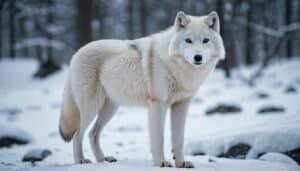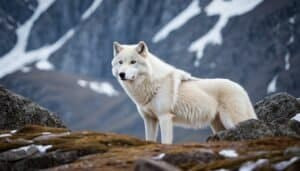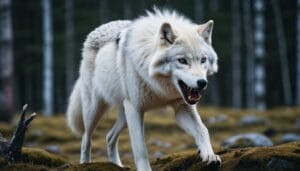Introduction
Arctic wolves thrive in some of the harshest environments on Earth, enduring extreme cold that would challenge most other species. A critical factor in their survival is the unique function of their kidneys, which have adapted to the cold in remarkable ways
This article will delve into the specific adaptations of Arctic wolf kidneys, including their structure and function compared to other canines, physiological and hormonal mechanisms, genetic and evolutionary influences, and how these adaptations support the survival of Arctic wolf pups
Understanding these mechanisms provides insight into the resilience and survival strategies of this remarkable predator
Kidney Structure and Function of Arctic Wolves
Arctic wolves have developed unique kidney structures and functions to survive the extreme cold of their environment. These adaptations are crucial for maintaining water and energy balance, which is essential for their survival in such harsh climates
Comparison with Other Canines
Compared to other canines, Arctic wolves exhibit significant differences in their kidney structure and function. One of the primary differences is the ability of their kidneys to concentrate urine more effectively
This adaptation is crucial in an environment where water is often scarce and exists primarily in the form of snow and ice. Studies have shown that Arctic wolves can produce urine that is more concentrated than that of other canines, which helps them conserve water and maintain hydration in their arid, cold habitat
Moreover, the nephrons, the functional units of the kidney, in Arctic wolves are adapted to reabsorb more water back into the bloodstream. This adaptation minimizes water loss and ensures that the wolves remain hydrated even when liquid water sources are not readily available
Research has indicated that the loop of Henle, a part of the nephron involved in concentrating urine, is longer in Arctic wolves compared to other canines, enhancing their ability to conserve water
Adaptations for Water Conservation
Water conservation is a critical function of the kidneys in Arctic wolves. In addition to the structural adaptations of their nephrons, Arctic wolves have developed several physiological mechanisms to minimize water loss
One such mechanism is the ability to extract metabolic water from their food. Arctic wolves predominantly consume meat, which has a high water content. The metabolism of fats and proteins in their diet produces water as a byproduct, which the wolves can utilize to stay hydrated
Furthermore, Arctic wolves have adapted to minimize water loss through their skin and respiratory system. In the cold, dry air of the Arctic, respiratory water loss can be significant
Arctic wolves have evolved to reduce the water vapor lost during respiration by cooling the exhaled air in their nasal passages, which condenses water vapor and allows it to be reabsorbed by the body
Energy Efficiency Mechanisms
In the extreme cold of the Arctic, energy conservation is as important as water conservation
The kidneys of Arctic wolves play a vital role in this process by efficiently managing metabolic waste without expending unnecessary energy. One of the key adaptations is the ability to maintain a stable internal environment through efficient thermoregulation and metabolism
Arctic wolves have a higher metabolic rate than many other canines, which generates more heat and helps them stay warm in freezing temperatures. Their kidneys support this high metabolic rate by efficiently filtering out waste products without losing excessive amounts of heat or energy
Additionally, the kidneys help manage the electrolyte balance in the blood, which is crucial for muscle function and overall metabolic processes
The kidneys also play a role in the conservation of energy by regulating the production of certain hormones that influence metabolism and energy usage. For example, the production of erythropoietin, a hormone that stimulates red blood cell production, is influenced by kidney function
In the cold, the increased production of red blood cells helps Arctic wolves maintain adequate oxygen levels in their tissues, supporting their high metabolic rate and energy needs
Physiological and Hormonal Mechanisms of Renal Adaptation
Arctic wolves possess intricate physiological and hormonal mechanisms that enable their kidneys to function optimally in freezing temperatures. These adaptations are critical for maintaining homeostasis and ensuring survival in such harsh environments
Blood Flow Changes in Cold Climates
In cold climates, blood flow to the kidneys is meticulously regulated to conserve heat and maintain the functionality of the renal system. Arctic wolves have developed a unique vascular structure that allows them to adjust blood flow based on temperature variations
This adaptation ensures that their kidneys receive an adequate blood supply while minimizing heat loss
One significant adaptation is the countercurrent heat exchange mechanism in the renal blood vessels. This system allows warm arterial blood flowing towards the kidneys to transfer heat to the cooler venous blood returning from the kidneys
This heat exchange helps conserve body heat while ensuring that the kidneys remain warm enough to function effectively. Studies have shown that this mechanism is more pronounced in Arctic wolves than in other canines, highlighting its importance in cold environments
Impact of Diet on Kidney Function
The diet of Arctic wolves plays a crucial role in their kidney function, especially in extreme cold
Arctic wolves primarily consume a high-protein, high-fat diet consisting of prey like caribou, muskoxen, and Arctic hares. This diet not only provides the necessary energy to endure the cold but also influences renal physiology
Protein metabolism generates a significant amount of nitrogenous waste, which the kidneys must efficiently excrete. Arctic wolf kidneys are adapted to handle this high load of urea, a byproduct of protein metabolism, without compromising water conservation
The ability to concentrate urine allows Arctic wolves to excrete urea in a minimal volume of water, thus retaining more water in their bodies
Additionally, the high-fat content in their diet provides metabolic water, reducing the wolves’ dependence on liquid water sources. The oxidation of fat produces water as a byproduct, which is a vital source of hydration in the arid Arctic environment
This adaptation ensures that even during periods of limited water availability, Arctic wolves can maintain hydration through their diet
Hormonal Changes in Cold Environments
Hormonal regulation plays a significant role in the renal adaptation of Arctic wolves. Hormones such as antidiuretic hormone (ADH), aldosterone, and erythropoietin are crucial for managing kidney function in response to cold stress
Antidiuretic hormone (ADH) is essential for water conservation. In cold environments, the secretion of ADH increases, leading to the reabsorption of more water in the kidneys and the production of highly concentrated urine. This mechanism helps Arctic wolves conserve water and maintain hydration despite the scarcity of liquid water
Aldosterone, another critical hormone, regulates sodium and potassium balance
Increased aldosterone secretion in cold climates ensures that sodium is reabsorbed efficiently in the kidneys, which helps maintain electrolyte balance and blood pressure. This adaptation is vital for sustaining overall physiological stability in the harsh Arctic conditions
Erythropoietin, produced by the kidneys, stimulates the production of red blood cells. In the cold, the increased demand for oxygen delivery to tissues prompts higher erythropoietin levels, supporting enhanced oxygen transport and utilization
This hormonal adjustment is crucial for maintaining metabolic rates and energy levels in Arctic wolves
Waste Management in Frigid Temperatures
Effective waste management is crucial for Arctic wolves to survive in frigid temperatures
Their kidneys are adapted to filter and excrete waste products efficiently, even in the cold. One adaptation is the increased concentration capacity of their kidneys, which allows them to excrete waste in a minimal volume of water, conserving precious bodily fluids
Arctic wolves also have a lower glomerular filtration rate (GFR) in cold environments. This reduction in GFR minimizes water loss while ensuring that waste products are still effectively removed from the bloodstream
The kidneys can adjust their filtration rate based on the wolf’s hydration status and environmental conditions, optimizing waste management in varying circumstances
Additionally, the renal system of Arctic wolves is equipped to handle the accumulation of nitrogenous waste from their protein-rich diet. The kidneys can process and excrete urea efficiently, preventing toxic buildup and maintaining metabolic balance
This capability is particularly important during prolonged periods of fasting or when prey is scarce, ensuring that the wolves can survive on limited resources
Genetic and Evolutionary Influences on Kidney Adaptation
The genetic and evolutionary history of Arctic wolves plays a pivotal role in the specialized function of their kidneys. These adaptations are the result of natural selection processes that have allowed Arctic wolves to thrive in their extreme environments over generations
Genetic Factors of Kidney Adaptation
Genetic adaptations are crucial for the efficient functioning of Arctic wolf kidneys in cold climates. Several genetic factors influence how these kidneys manage to conserve water, maintain electrolyte balance, and handle metabolic waste
One key genetic adaptation is the variation in genes responsible for the expression of aquaporins, which are proteins that form water channels in the kidney cells. These channels are essential for reabsorbing water from the filtrate back into the bloodstream
Arctic wolves have a higher expression of certain aquaporin genes, particularly those involved in water reabsorption in the collecting ducts of the nephrons, enhancing their ability to concentrate urine and conserve water
Additionally, genetic studies have identified adaptations in genes related to urea transporters, which are crucial for handling the high protein diet of Arctic wolves
These transporters facilitate the efficient movement of urea across cell membranes, allowing the kidneys to excrete urea effectively while conserving water. This genetic adaptation ensures that Arctic wolves can process large amounts of protein without suffering from dehydration
Evolutionary Changes in the Renal System
The evolutionary process has fine-tuned the renal system of Arctic wolves to cope with the extreme cold and scarce resources of their environment. Over thousands of years, natural selection has favored individuals with renal systems capable of conserving water and managing energy efficiently
One significant evolutionary change is the development of a more extensive medullary region in the kidneys. The medulla is the innermost part of the kidney and plays a crucial role in concentrating urine
In Arctic wolves, the medulla is proportionally larger compared to other canines, allowing for greater reabsorption of water and more concentrated urine output . This structural adaptation is a direct result of evolutionary pressures to maintain hydration in a frigid, arid habitat
Furthermore, the length of the loop of Henle, a key component of the nephron, is longer in Arctic wolves. This longer loop enhances the kidney’s ability to create a concentration gradient, which is essential for water reabsorption
The evolutionary elongation of the loop of Henle is a critical adaptation that enables Arctic wolves to survive in environments where liquid water is not readily available
Interaction with Other Organs
The kidneys of Arctic wolves do not work in isolation; they interact closely with other organs to maintain overall homeostasis
One notable interaction is with the adrenal glands, which produce hormones like aldosterone that regulate sodium and potassium balance. This hormonal interaction ensures that electrolyte levels are maintained even in challenging conditions
Additionally, the kidneys play a vital role in supporting the cardiovascular system. By regulating blood volume and pressure through water and sodium balance, the kidneys help maintain adequate circulation and oxygen delivery to tissues. This interaction is crucial for thermoregulation and energy metabolism, allowing Arctic wolves to generate and conserve heat in their bodies
The liver also interacts with the kidneys in waste management and detoxification. The kidneys and liver work together to process and excrete metabolic waste products, ensuring that toxins do not accumulate in the body
This collaboration is particularly important during periods of fasting or when prey is scarce, as it ensures that Arctic wolves can continue to function optimally even with limited food intake
Kidney Function in Arctic Wolf Pups
The kidneys of Arctic wolf pups undergo significant adaptations from birth to ensure their survival in the extreme cold. These adaptations are critical for managing water and electrolyte balance, energy conservation, and overall development in a harsh environment
Kidney Adaptation in Arctic Wolf Pups
From birth, Arctic wolf pups face the challenge of maintaining hydration and energy balance in freezing temperatures. Their kidneys are not fully developed at birth, but they rapidly adapt to their environment through various physiological mechanisms
One key adaptation is the accelerated development of the nephron’s concentrating ability
Initially, Arctic wolf pups have a limited ability to concentrate urine, which poses a risk of dehydration in their cold and arid habitat. However, studies have shown that within the first few weeks of life, the pups’ kidneys undergo significant maturation, enhancing their ability to reabsorb water and produce more concentrated urine
Another important adaptation is the increased expression of aquaporins in the renal cells of pups. This genetic adaptation facilitates the rapid reabsorption of water from the filtrate back into the bloodstream, crucial for maintaining hydration
The upregulation of aquaporin genes in response to cold stress ensures that even young pups can conserve water efficiently
Kidney Function and Thermoregulation
Thermoregulation is vital for the survival of Arctic wolf pups, and their kidneys play a supportive role in this process. The kidneys contribute to thermoregulation by managing blood volume and pressure, which affects heat distribution throughout the body
In cold environments, Arctic wolf pups have a higher metabolic rate to generate sufficient body heat
The kidneys support this increased metabolic rate by efficiently filtering blood and maintaining electrolyte balance, which is crucial for muscle function and overall metabolism. The renal system’s ability to conserve sodium and water helps maintain blood volume, supporting circulation and heat distribution
Additionally, the kidneys help regulate the production of erythropoietin, a hormone that stimulates red blood cell production. Higher levels of erythropoietin in response to cold stress ensure that Arctic wolf pups have an adequate oxygen supply in their tissues, supporting their metabolic and thermogenic needs
The interaction between the kidneys and the endocrine system also plays a role in thermoregulation
Hormones such as aldosterone and antidiuretic hormone (ADH) help maintain water and electrolyte balance, crucial for sustaining body temperature in cold environments. The kidneys’ response to these hormones ensures that Arctic wolf pups can retain water and sodium, reducing the risk of dehydration and hypothermia
Developmental Stages of Renal Adaptation
The developmental stages of renal adaptation in Arctic wolf pups are marked by significant physiological changes
In the early stages of life, the pups rely heavily on their mother’s milk, which provides both hydration and nutrients. As they transition to solid food, their kidneys adapt to handle a higher load of nitrogenous waste from a protein-rich diet
During weaning, the kidneys undergo rapid maturation, enhancing their ability to concentrate urine and manage waste products. This developmental process is crucial for preparing the pups to survive on their own in the harsh Arctic environment. Research indicates that the timing of renal maturation is closely linked to the weaning period, highlighting the importance of a gradual dietary transition
The growth of the renal cortex and medulla during the early stages of life is also notable. The renal cortex, where most filtration occurs, expands to accommodate increased blood flow and filtration demands
The medulla, essential for urine concentration, also grows, improving the kidneys’ ability to conserve water and excrete concentrated urine. These structural changes are vital for the pups’ overall survival and development
Conclusion
The Arctic wolf’s kidneys demonstrate remarkable adaptations that allow these animals to thrive in one of the harshest environments on Earth
From structural differences compared to other canines to specialized physiological and hormonal mechanisms, these adaptations are critical for maintaining water and energy balance in extreme cold. Genetic and evolutionary changes have fine-tuned their renal systems, ensuring efficient waste management and thermoregulation
Moreover, the developmental stages of Arctic wolf pups highlight the rapid maturation of their kidneys, preparing them for survival from a young age. These combined adaptations underscore the incredible resilience of Arctic wolves, enabling them to endure the severe conditions of their habitat
Understanding these mechanisms not only provides insight into the survival strategies of Arctic wolves but also enhances our knowledge of how mammals can adapt to extreme environments. This knowledge could be valuable in studying other species facing similar challenges and in developing conservation strategies to protect these magnificent creatures










